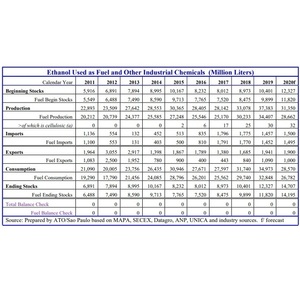Report: Brazilian ethanol production expected to fall 16% in 2020

September 21, 2020
BY Erin Voegele
Brazil is expected to produce 31.35 billion liters (8.28 billion gallons) of ethanol this year, down 16 percent from 2019, according to a report recently filed with the USDA Foreign Agricultural Service’s Global Agricultural Information Network. The reduction is primarily attributed to mills diverting more sugarcane to the production of sugar.
Of the 31.35 billion liters of Brazilian ethanol expected to be produced this year. Approximately 28.66 billion liters is expected to be used as transportation fuel. An estimated 32 million liters of ethanol is expected to be sourced from cellulosic feedstocks.
Brazil is expected to import 1.5 billion liters of ethanol this year, up from 1.457 billion liters in 2019. Imports of fuel ethanol are expected to reach 1.495 billion liters in 2020, up from 1.452 billion liters last year.
The country is expected to export approximately 1.9 billion liters of ethanol this year, down from 1.941 billion liters in 2019. Exports of fuel ethanol are forecast at 1 billion liters, down slightly from 1.09 billion liters in 2019.
Advertisement
Advertisement
Brazil is expected to consume 28.57 billion liters of ethanol in 2020, including 26.782 billion liters of fuel ethanol. Last year, the country consumed 34.973 billion liters of ethanol, including 32.848 billion liters of fuel ethanol.
The report estimates Brazil currently has 360 operational first-generation ethanol production facilities, with a combined nameplate capacity of 42.8 billion liters. Those facilities are expected to operate at 67 percent capacity in 2020. Last year, Brazil had 359 operational facilities with a combined nameplate capacity of 43.105 billion liters. Those facilities operated at an estimated 80 percent capacity in 2019.
Brazil also has three cellulosic ethanol plants with a combined capacity of 127 million gallons per year. The number of facilities and their combined nameplate capacity has held steady since 2015. The cellulosic plants are expected to operate at 25 percent capacity this year, up slightly from 24 percent in 2019.
An estimated 326.63 million tons of sugarcane is expected to go to fuel ethanol production this year, down form 413.088 million tons last year. The volume of corn used in fuel ethanol production, however, is expected to increase from 3.19 metric tons in 2019 to 5.995 million metric tons in 2020.
Advertisement
Advertisement
According to the report, total Brazilian corn ethanol production is expected to reach 2.5 billion liters this year, an increase of 1.17 billion liters when compared to 2019. Currently, corn ethanol represents approximately 8 percent of total ethanol production in Brazil. Corn ethanol production is expected to increase to 8 billion liters by 2028.
The report cites data showing Brazil currently has 11 operational corn ethanol plants, including nine dedicated corn ethanol production facilities and two flex-plants that can produce ethanol using either corn or sugarcane feedstock. Together, these 11 plants have a combined production capacity of 2.5 billion gallons.
A full copy of the report can be downloaded from the USDA FAS GAIN website.
Related Stories
The USDA on April 14 announced the cancellation of its Partnerships for Climate-Smart Commodities program. Select projects that meet certain requirements may continue under a new Advancing Markets for Producers initiative.
The Michigan Advanced Biofuels Coalition and Green Marine are partnering to accelerating adoption of sustainable biofuels to improve air quality and reduce GHG emissions in Michigan and across the Great Lakes and St. Lawrence Seaway.
The USDA reduced its outlook for 2024-’25 soybean oil use in biofuel production in its latest World Agricultural Supply and Demand Estimates report, released April 10. The outlook for soybean oil pricing was revised up.
EIA reduces production forecasts for biobased diesel, increases forecast for other fuels, including SAF
The U.S. Energy Information Administration reduced its 2025 forecasts for renewable diesel and biodiesel in its latest Short-Term Energy Outlook, released April 10. The outlook for “other biofuel” production, which includes SAF, was raised.
FutureFuel Corp. on March 26 announced the restart of its 59 MMgy biodiesel plant in Batesville, Arkansas. The company’s annual report, released April 4, indicates biodiesel production was down 24% last year when compared to 2023.
Upcoming Events










